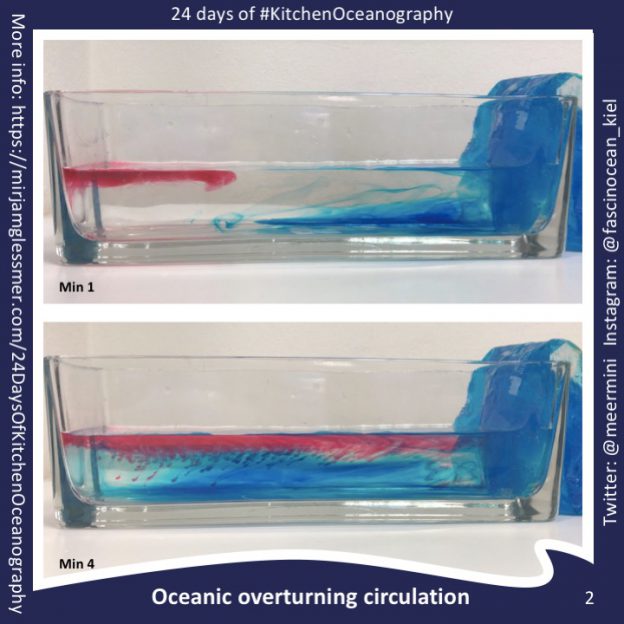Welcome to 24 days of #KitchenOceanography! Both English and German instructions below.
Herzlich Willkommen zu 24 Tagen Küchen-Ozeanographie! Deutsche und Englische Anleitungen weiter unten.
![[graphic] Instructions for prepratations for day 2: put coolpack in freezer](https://mirjamglessmer.com/wp-content/uploads/2019/12/Slide10.jpeg)
![[graphic with text] Umwälzzirkulation des Ozeans Warum fließt oben das rote und unten das blaue Wasser? Wir füllen lauwarmes Wasser in ein rechteckiges Gefäß. Dann platzieren wir ein eiskaltes Kühlpack auf der rechten Seite des Gefäßes im Wasser. Auf das Kühlpack wird blaue, an der linken Seite des Gefäßes erwärmte rote Lebensmittelfarbe getropft. Die blaue Lebensmittelfarbe markiert dann die am Kühlpack gekühlte Wassermasse, deren Dichte durch das Kühlen ansteigt und die deshalb absinkt. Die rote Farbe markiert das warme Wasser an der Oberfläche. Durch das ständige Absinken des blauen, kalten Wassers, das sich dann am Boden entlang ausbreitet, entsteht oben am Kühlpack ein Sog. Warmes Wasser wird angesogen und kühlt dann am Kühlpack ab, bis es ebenfalls absinkt.](https://mirjamglessmer.com/wp-content/uploads/2019/12/Slide12.jpeg)
![[Graphic with text] Oceanic overturning circulation: Why does the red water flow on top and the blue water at the bottom? We take a rectangular container and fill it with lukewarm water. We then place a frozen cool pack over the edge on the right side. Now we drip blue food coloring on the cool pack, and drip warm red food coloring on the left edge. The blue color marks the water mass cooled by the cooling pack, the density of which increases as a result of the cooling and which therefore sinks to the bottom of the container. The red color marks the warm water on the surface. Due to the constant sinking of the cold water and its spreading along the bottom, warm water is pulled towards the cool pack and cools there until it starts sinking, too.](https://mirjamglessmer.com/wp-content/uploads/2019/12/Slide13.jpeg)

Welcome to 24 days of #KitchenOceanography! Both English and German instructions below.
Herzlich Willkommen zu 24 Tagen Küchen-Ozeanographie! Deutsche und Englische Anleitungen weiter unten.
![[graphic] Instructions for prepratations for day 2: put coolpack in freezer](https://mirjamglessmer.com/wp-content/uploads/2019/12/Slide10.jpeg)
![[graphic with text] Umwälzzirkulation des Ozeans Warum fließt oben das rote und unten das blaue Wasser? Wir füllen lauwarmes Wasser in ein rechteckiges Gefäß. Dann platzieren wir ein eiskaltes Kühlpack auf der rechten Seite des Gefäßes im Wasser. Auf das Kühlpack wird blaue, an der linken Seite des Gefäßes erwärmte rote Lebensmittelfarbe getropft. Die blaue Lebensmittelfarbe markiert dann die am Kühlpack gekühlte Wassermasse, deren Dichte durch das Kühlen ansteigt und die deshalb absinkt. Die rote Farbe markiert das warme Wasser an der Oberfläche. Durch das ständige Absinken des blauen, kalten Wassers, das sich dann am Boden entlang ausbreitet, entsteht oben am Kühlpack ein Sog. Warmes Wasser wird angesogen und kühlt dann am Kühlpack ab, bis es ebenfalls absinkt.](https://mirjamglessmer.com/wp-content/uploads/2019/12/Slide12.jpeg)
![[Graphic with text] Oceanic overturning circulation: Why does the red water flow on top and the blue water at the bottom? We take a rectangular container and fill it with lukewarm water. We then place a frozen cool pack over the edge on the right side. Now we drip blue food coloring on the cool pack, and drip warm red food coloring on the left edge. The blue color marks the water mass cooled by the cooling pack, the density of which increases as a result of the cooling and which therefore sinks to the bottom of the container. The red color marks the warm water on the surface. Due to the constant sinking of the cold water and its spreading along the bottom, warm water is pulled towards the cool pack and cools there until it starts sinking, too.](https://mirjamglessmer.com/wp-content/uploads/2019/12/Slide13.jpeg)